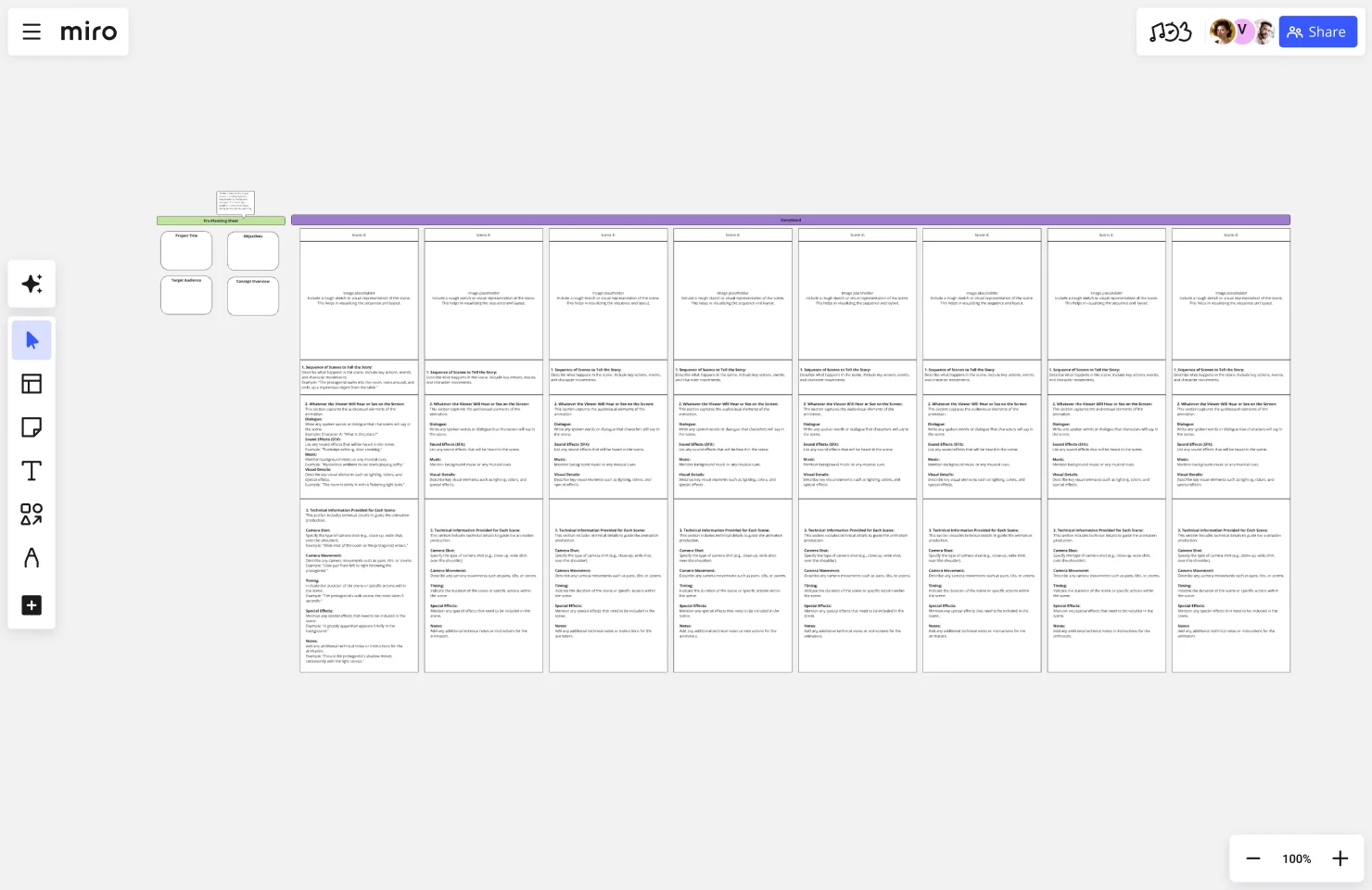Storyboard for Animation Template
The storyboard for animation template helps visualize and organize every stage of animation production, supporting collaboration and bringing your vision to life with clarity.
About the Storyboard for Animation Template
The "Storyboard for Animation" template in MIRO is a comprehensive tool designed to help animators plan and visualize their animation projects. This template is structured to cover all essential aspects of animation production, ensuring a smooth workflow and clear communication among team members. Each frame or scene in the template includes three main sections:
Sequence of Scenes to Tell the Story:
Scene Number: A unique identifier for each scene.
Action Description: A detailed description of what happens in the scene, including key actions, events, and character movements.
Storyboard Image: A rough sketch or visual representation of the scene to help visualize the sequence and layout.
Whatever the Viewer Will Hear or See on the Screen:
Dialogue: The spoken words or dialogue that characters will say in the scene.
Sound Effects (SFX): A list of sound effects that will be heard in the scene.
Music: Background music or musical cues.
Visual Details: Key visual elements such as lighting, colors, and special effects.
Technical Information Provided for Each Scene:
Camera Shot: The type of camera shot (e.g., close-up, wide shot, over-the-shoulder).
Camera Movement: Any camera movements such as pans, tilts, or zooms.
Timing: The duration of the scene or specific actions within the scene.
Special Effects: Any special effects that need to be included in the scene.
Notes: Additional technical notes or instructions for the animators.
Why Use This Template?
1. Structured Planning:
The template provides a clear, organized way to break down the animation into manageable scenes. This ensures that the storyline is coherent and well-paced.
2. Visual Clarity:
By visualizing each scene, animators can better understand how the animation will look and feel. This is crucial for creating an immersive and engaging viewing experience.
3. Collaboration:
MIRO’s collaborative features allow multiple team members to work on the storyboard simultaneously. This fosters teamwork and ensures that everyone is aligned with the project’s vision.
4. Efficiency:
Having a predefined template saves time. Animators don’t have to start from scratch and can focus more on the creative aspects of animation.
5. Consistency:
Using a template ensures consistency in documenting each scene, making it easier to review and edit the animation as a whole.
6. Communication:
A well-documented storyboard serves as a communication tool between different departments (e.g., writers, animators, sound designers). It ensures that the vision for the animation is clearly conveyed and understood by all stakeholders.
7. Problem-Solving:
By mapping out each scene, potential issues or gaps in the narrative can be identified and addressed early in the development process.
8. Inspiration:
The template can spark new ideas and creative solutions. By visualizing scenes, animators might come up with innovative ways to enhance storytelling and animation techniques.
9. Documentation:
The storyboard serves as a living document that can be updated and referred back to throughout the development process, ensuring that the original vision is maintained.
Using the "Storyboard for Animation" template in MIRO helps animators create a detailed and visually engaging plan for their projects, ensuring a smooth development process and a compelling final product.
Discover more storyboard examples and map your next project.
Get started with this template right now.
Design Brief Template
Works best for:
Design, Marketing, UX Design
For a design to be successful, let alone to be great, design agencies and teams have to know the project’s goals, timelines, budget, and scope. In other words, design takes a strategic process—and that starts with a design brief. This helpful template will empower you to create a brief that builds alignment and clear communication between your business and your design agency. It’s the foundation of any creative project, and a single source of truth that teams can refer to all along the way.
Visual Prototyping Template
Visual and emotional aspects play a vital role in determining a product or service's usability and user experience. To evaluate these aspects of your proposed solution, consider using the Visual Prototyping Template. By creating a model that closely resembles the real product or service, and gathering feedback from key stakeholders, you can assess whether the form of your creation is advantageous or detrimental.
UX Research Repository Template
Works best for:
UX Design, User Experience
Empower your organization with customer knowledge and build a centralized research hub. From UX designers to product managers, enable everyone to get insights using the Research Repository Template.
Creative Brief Template
Works best for:
Design, Marketing, Desk Research
Even creative thinkers (or maybe especially creative thinkers) need clear guidelines to push their ideas in productive, usable directions. And a good creative lays down those guidelines, with information that includes target audience, goals, timeline, and budget, as well as the scope and specifications of the project itself. The foundation of any marketing or advertising campaign, a creative brief is the first step in building websites, videos, ads, banners, and much more. The brief is generally prepared before kicking off a project, and this template will make it easy.
System Flowchart Template
The System Flowchart Template is a visual representation of the structure and organization of a concept, system, or solution. It helps teams understand how different components interact to form a functional system by focusing on the overall arrangement of elements rather than specific details. Symbolic drawings are used to illustrate the basic parts and their relationships in the diagram.
Analytics Storyboard
Works best for:
Planning, Storyboard, Design
Visualize your data insights with the Analytics Storyboard template. This tool is perfect for data analysts and business intelligence teams, helping you present complex data in a clear and engaging narrative format. It includes sections for data sources, key findings, and visualizations, ensuring your audience can easily understand and act on your insights. Use this template to create compelling data stories that drive informed decision-making and strategic planning.
